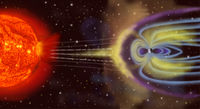
Photo from wikipedia
Correlations between solar, interplanetary-medium parameters, and geomagnetic-activity proxies in 27-day averages (a Bartels rotation) were analyzed for the 2009 – 2016 time interval. In this analysis, two new proxies were considered: i) … Click to show full abstract
Correlations between solar, interplanetary-medium parameters, and geomagnetic-activity proxies in 27-day averages (a Bartels rotation) were analyzed for the 2009 – 2016 time interval. In this analysis, two new proxies were considered: i) $B_{zs}$ GSM (Geocentric Solar Magnetic), calculated as the daily percentage of the IMF southward component along the GSM $z$ -axis and then averaged every 27 days; ii) four magnetospheric indices (T-indices), calculated from the local north–south ( $x$ ) contributions of the magnetosphere’s cross-tail (TAIL), the symmetric ring current (SRC), the partial ring current (PRC), and the Birkeland current (FAC), derived from the Tsyganenko and Sitnov (J. Geophys. Res. 110, A03208, 2005: TS05) semi-empirical magnetospheric model. Our results suggest that, among the parameters tested in this study, solar facular areas, interplanetary magnetic-field intensity and new proxies derived from the TS05 model could be taken into account in an empirical model, with a 27-day resolution, to explain geomagnetic activity felt on the Earth’s surface in terms of solar-surface features and the IMF condition. We further retrieve a clear annual oscillation in series of 27-day-mean values of toward/away asymmetries of geomagnetic-activity indices, which can be interpreted in the light of the Russell–McPherron hypothesis for the semiannual variation of geomagnetic activity.
Journal Title: Solar Physics
Year Published: 2021
Link to full text (if available)
Share on Social Media: Sign Up to like & get
recommendations!